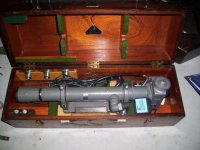It was me who suggested old HD platters to RC as that's what I use, however there is some incorrect information in this thread. Firstly, modern HD platter disks are made of aluminium, and they are VERY flat. I can't recall the figures off the top on my head, but they're ever bit as flat as some if the best optical mirrors. They are also polished to an exceptionally high finish, around 1 angstrom before coating. A benefit of the platters is that they are coated with a very tough coating to resist damage with head crashes, so they stand up to workshop use much better than schmuck optical mirrors.
A poorer quality mirror doesn't necessarily produce a a dimmer reflection, instead the reflection won't be in good focus. The reflected line appears to be "fuzzy" for want if a better description, and it's difficult to align anything properly. Indeed that can be a potential use of an AC in determining mirror quality from samples, although as far as I'm aware the results are only ever subjective. The brightness of the reflection is instead determined by the size of the mirror and the distance from the autocollimator.
Don't overlook the humble HD platter for this type of thing, it's something we take for granted, especially given the cost, but the science and technology within them is truly astounding.







